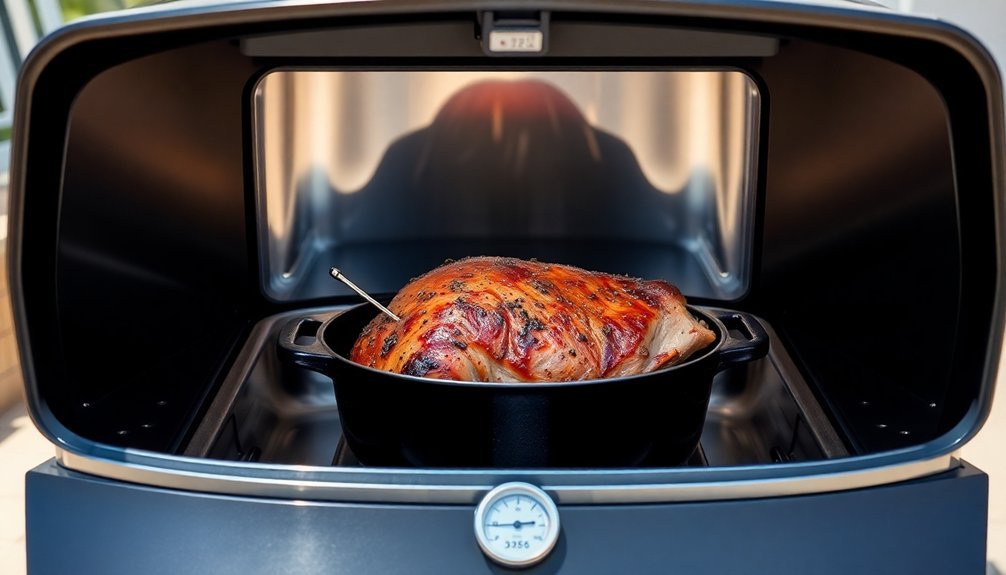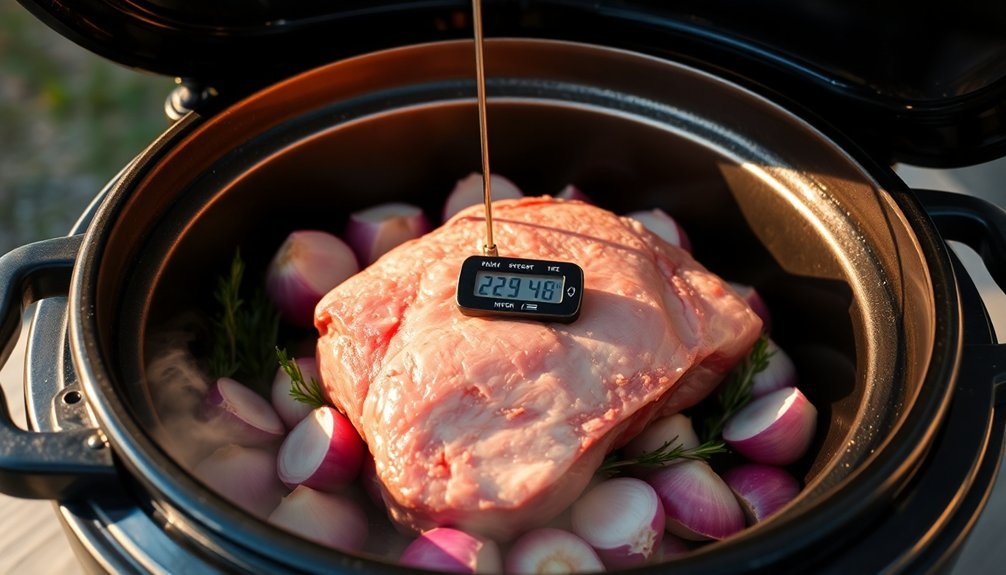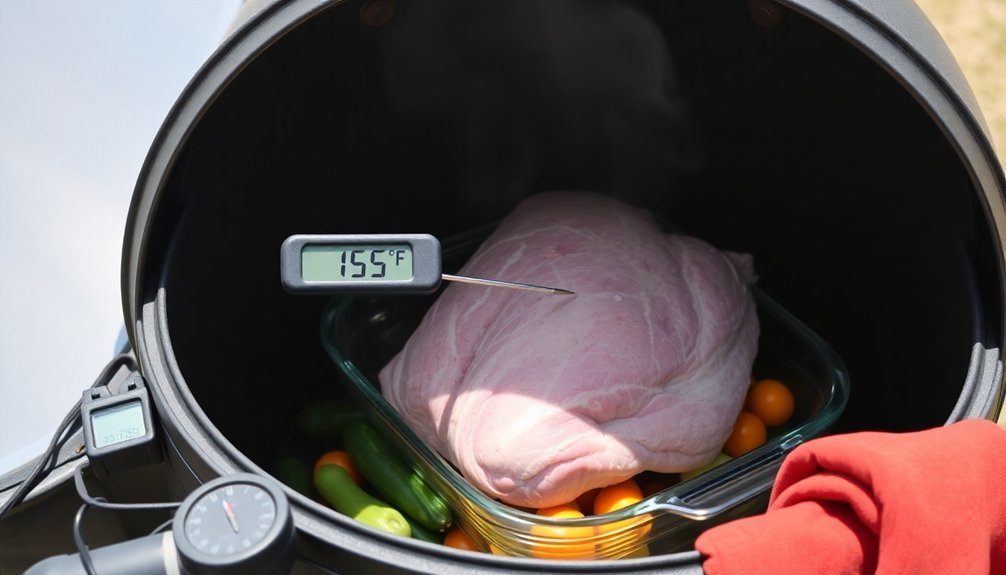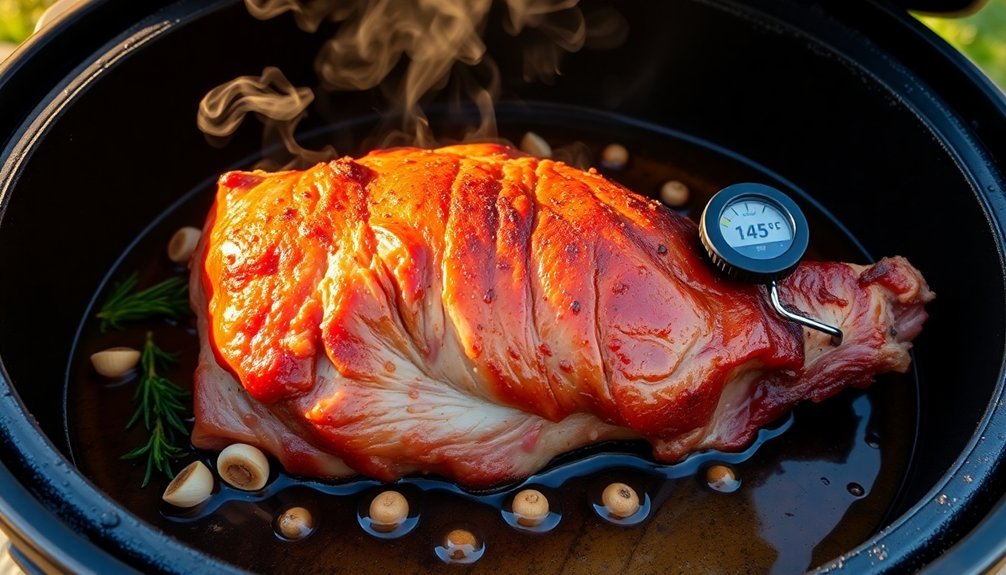For foolproof solar-cooked pork, you'll need to focus on five key elements. Start by selecting a reliable solar oven – vacuum tube cookers offer the fastest results and work well in low light. Keep your cooking temperature steady between 150-225°F by adjusting the oven's position every 30-45 minutes. Prepare your pork properly by patting it dry and seasoning well, then use dark-colored cookware for better heat absorption. Track the sun's movement carefully, repositioning your cooker every 10-20 minutes for consistent heat. Always verify your pork reaches 180°F internal temperature for safety. These fundamentals will set you up for solar cooking success, but there's much more to master.
Choose Your Solar Oven Wisely

Success with solar-cooked pork tips starts by selecting the right solar oven for your needs.
For the best results with pork, consider a vacuum tube cooker like the GoSun Sport or a parabolic dish cooker like SolSource. These models offer faster cooking times of 15-30 minutes and reach higher temperatures, which is essential for safely cooking meat. The GoSun Sport can achieve internal temperatures around 550°F, making it perfect for thoroughly cooking pork.
If you're cooking for a larger group, you'll want to opt for a box oven like the All American Sun Oven, which can serve 4-10 people.
While panel cookers are budget-friendly, they're not ideal for pork due to their slower cooking times of over 150 minutes.
Remember that vacuum tube cookers work well even in low light conditions, making them more reliable for meat preparation throughout the day.
Perfect Temperature Control Methods
While mastering solar cooking requires practice, controlling temperature begins with proper oven positioning and monitoring. You'll need to face your solar oven directly toward the sun and reposition it every 30-45 minutes to maintain consistent heat. Choose a wind-sheltered spot for maximum performance.
For safe pork cooking, verify your oven reaches at least 180°F. Use a reliable thermometer or Type-K thermocouple for precise readings. The general cooking range should stay between 150-225°F. Remember that cloudy conditions will double your cooking time, so plan accordingly. Proper use of insulation and reflection with multiple layers can help maintain steady temperatures even in less-than-ideal conditions.
Cover your cookware with dark-colored lids to trap heat and moisture. Don't use aluminum foil on the food itself, as it'll reflect precious sunlight away.
For automated temperature management, consider installing servo motors to track the sun's movement throughout the day.
Proper Pork Preparation Steps

Before diving into solar cooking, proper pork preparation establishes the foundation for a delicious meal.
Begin by thawing your pork chops slowly in the refrigerator to maintain quality. Once thawed, pat them dry with paper towels to guarantee ideal browning.
For maximum flavor and tenderness, you'll want to properly season your pork. You can either brine it in saltwater or create a marinade using cranberry juice, water, and soy sauce. After seasoning, coat each chop by dipping in well beaten egg and dredging in breadcrumbs.
Don't forget to let the meat rest at room temperature for 30 minutes before cooking.
- Generously season with salt, pepper, and spices
- Consider using dry onion soup mix for enhanced flavor
- Dredge in egg wash and bread crumbs for a crispy exterior
- Place in a dark-colored, solar-safe cooking vessel
- Arrange in a single layer to guarantee even cooking
Sun Tracking For Best Results
Getting the most out of your solar cooker depends heavily on how you track the Sun throughout the day. You'll need to position your cooker facing directly south and adjust it every 10-20 minutes to follow the Sun's movement across the sky.
If you're cooking for long periods, consider using an automated sun tracker that'll adjust your cooker's angle automatically. These devices use shadow patterns to maintain ideal exposure without constant monitoring.
For consistent results, you'll want to pre-heat your cooker for 15-20 minutes and use dark-colored, lidded cookware to maximize heat absorption and retention.
Keep a thermometer handy to monitor internal temperatures, and verify your cooking pot stays at the focal point where sunlight concentrates. Using reflective surfaces like mirrors can help intensify the heat for more efficient cooking.
Essential Safety Precautions

Since solar cooking involves both food safety and sun exposure, you'll need to follow essential precautions to guarantee a safe cooking experience.
Always verify your pork reaches an internal temperature of at least 180°F, confirmed with a cooking thermometer. Keep the meat out of the danger zone (40-140°F) to prevent bacterial growth.
When working with your solar cooker, protect your eyes and skin from intense reflections, and position the cooker on level ground away from children's reach.
To prevent cross-contamination, handle raw and cooked pork separately.
- Use clean, sanitized equipment and workspace
- Monitor internal temperature regularly
- Don't stir the meat; rotate it every 10-15 minutes
- Keep the cooker in direct sunlight, away from shadows
- Store leftovers promptly above 145°F until serving
Frequently Asked Questions
Can I Use Frozen Pork in a Solar Oven?
You can use frozen pork in a solar oven, but you'll need to thaw it completely first. This guarantees even cooking, prevents bacterial growth, and helps maintain proper texture while reaching safe internal temperatures.
What Happens if It Rains Halfway Through Cooking?
If it rains halfway through cooking, you'll need to switch to an alternative cooking method like a propane stove or BBQ. Move your pork indoors immediately and continue cooking to guarantee it reaches a safe temperature.
Does Marinading Time Need to Be Adjusted for Solar Cooking?
You don't need to adjust marinade time for solar cooking – stick to standard 12-18 hour periods. The gentle, even heat of solar cooking actually helps preserve and enhance the marinade's flavors during cooking.
Can I Stack Multiple Cooking Pots in One Solar Oven?
Yes, you can stack multiple pots in compatible solar ovens. You'll have the best results using round pots double-stacked on a leveling tray in models like the Global Sun Oven or SunFocus.
How Long Can I Safely Keep Leftovers From Solar-Cooked Pork?
You can keep solar-cooked pork in your fridge for 3-4 days at 40°F or below. If you'd like to store it longer, freeze it for up to 6 months but use it within 2-3 months for best quality.
In Summary
You'll find solar cooking pork delivers incredible flavor when you follow these guidelines carefully. Remember to track the sun's movement, maintain proper temperatures, and never skip safety protocols. With the right solar oven and proper meat preparation, you're set for success. Keep practicing these techniques, and you'll soon master the art of solar-cooked pork that's tender, juicy, and perfectly done every time.





Leave a Reply